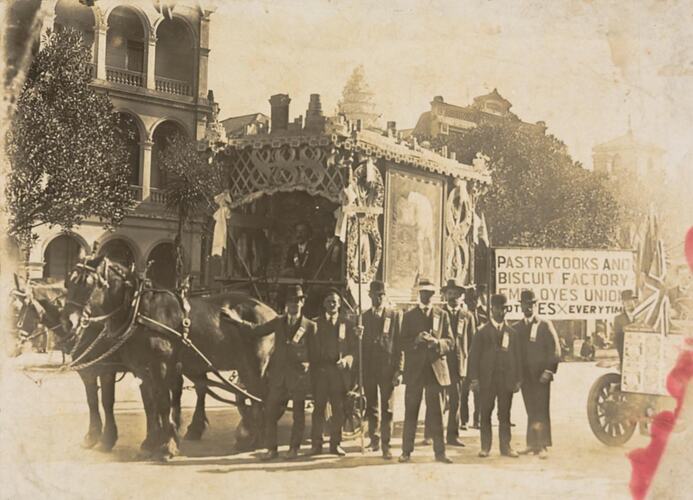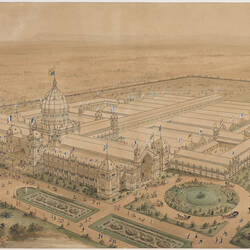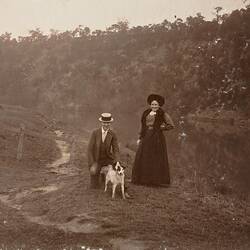Summary
Black and white photograph showing Richard Henry 'Dick' Archer and other workers from the Swallow and Ariell Biscuit Factory at the Eight Hour Day march, Melbourne, circa 1900-1910. Dick Archer is standing fifth from left.
According to the Archer family, Dick Archer had to work on Saturdays as well as weekdays at the Swallow and Ariell Biscuit Factory. His children were young at this time. Other members of the Archer family also worked at the factory, including Jack Archer who lived at Coburg who, on some occasions, marched in front of the float with a baton. The Archer family remembers that 'The Swallow & Ariell staff marched with the Pastry Cooks and Biscuit Factory Cooks Union.' The sign in the photograph states that the union name is actually the Pastry Cooks and Biscuit Factory Employees Union. This union can be traced back to the first industrial organisation in Victoria which was for pastry cooks. It later changed its name several times due to merging with other related trades such as flour and sugar goods workers.
The Eight Hour Day march commemorated a successful protest march held on April 21, 1856 by Victorian stonemasons and other members of the building trades. The protest resulted in an agreement by the Victorian Government to ensure all workers on public sites had an eight hour working day. In recognition of the significance of this achievement, April 21 was made a public holiday in 1879 and commemorative marches were held each year from 1879 until 1951. The Eight Hour Day holiday was renamed Labour Day in 1934. In 1955 the Labour Day march and celebrations were replaced by Moomba celebrations.
Swallow & Ariell Ltd have a long standing history in Melbourne and can also be connected with the Melbourne international exhibitions of 1880 and 1888. This Australian Biscuit Company was established in 1854 and was based in Port Melbourne. The company set up their exhibit at the Melbourne Centennial International Exhibition in the Victorian Machinery Annexe, on the eastern side of the New South Wales Court, and was open to visitors throughout the duration of the exhibition from 1:00pm until 10:00pm, daily.
Description of Content
Eight men in suits and hats standing in front of an elaborately decorated horse drawn float. There are two draught horses harnessed to the float. A man is at the reins and another man is inside the float behind the driver. There is a '888' sign over the driver's head. The side of the float shows two '8's with a painting of a worker in between. A sign held behind the float states 'Pastry Cooks and Biscuit Factory Employees Union...Vote Yes Everytime.' Multi-storey houses are visible in the background on the other side of the street. A motor car float with a British flag flying is at front right.
More Information
-
Collection Names
-
Collecting Areas
-
Acquisition Information
Copied from Ms Judy Archer, 07 Dec 2006
-
Place & Date Depicted
Melbourne, Greater Melbourne, Victoria, Australia, circa 1900-1910
The presence of an early motor car in the image suggests it is likely to be between 1900-1910, as cars weren't common until early 20th century. The image can not have been taken later than 1911 as the union changed its name in 1911. -
Individuals Identified
Archer, Richard Henry (Dick); other people unknown
-
Format
Digital file, TIFF, Monochrome
-
Inscriptions
Reverse - see supplementary file for printout of text attached to back of photograph. This is contemporary information provided by the Archer family, probably attached at the time that they contributed the image to the museum.
-
Classification
-
Category
-
Discipline
-
Type of item
-
References
Australian Trade Union Association [Link 1] [Link 2] Eight Hour Day Organisation [Link 3] Only Melbourne:The Eight Hour Day March [Link 4] Company name [Link 5]
-
Keywords
8 Hours Day Celebrations, Cooks, Food Workers, Horsedrawn Vehicles, Labour Day, Manufacturing, Marchers, Parade Floats, Parades, Street Marches, Trade Unions, Workers Rights, Working Life, Making History - Eight Hour Day


